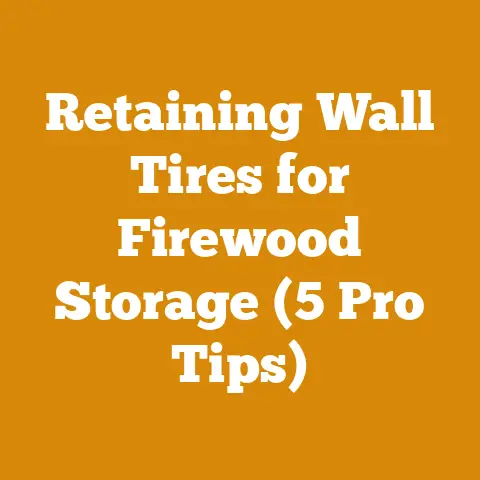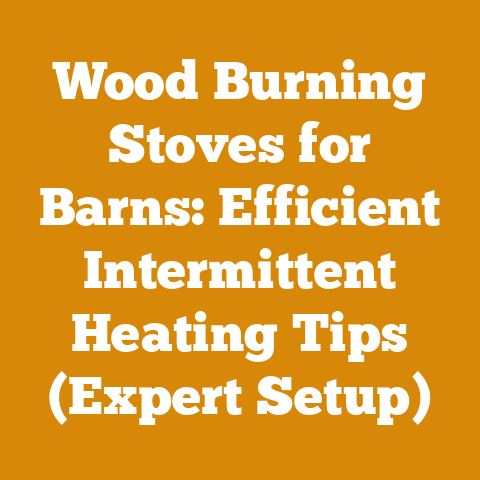Forester Wood Stove Tips (5 Pro Hacks for Better Heat)
The biting wind howled outside, rattling the windows of my little cabin nestled deep in the Adirondack Mountains. Inside, a comforting warmth radiated from my Forester wood stove, chasing away the winter’s chill. It’s a feeling I’ve come to cherish, a tangible reward for the hours spent felling trees, splitting logs, and meticulously preparing firewood. But getting to this point wasn’t always easy. I remember early winters where I’d be perpetually feeding the stove, battling inconsistent heat, and struggling to maintain a decent fire. Through trial and error, countless hours of research, and conversations with seasoned woodsmen, I’ve learned a few pro hacks that have drastically improved my wood stove performance. Now, I’m sharing them with you.
This isn’t just about keeping warm; it’s about efficiency, safety, and respecting the resource that keeps us comfortable. So, grab a mug of something warm, pull up a chair, and let’s dive into the secrets of maximizing your Forester wood stove’s potential.
Forester Wood Stove Tips: 5 Pro Hacks for Better Heat
These hacks are born from my personal experience, coupled with the best practices I’ve gleaned from the forestry and wood-burning communities. They cover everything from wood selection and preparation to stove maintenance and burning techniques. I’ve included data points, safety advice, and practical examples to ensure you get the most out of your wood-burning experience.
1. Mastering the Art of Wood Selection: Fueling Your Fire with Precision
The type of wood you burn has a monumental impact on heat output, burn time, and overall stove efficiency. It’s not just about throwing any old log into the firebox. Understanding the properties of different wood species is crucial.
Hardwoods vs. Softwoods:
- Hardwoods: These woods are denser and burn hotter and longer than softwoods. Ideal hardwoods include oak, maple, ash, beech, and birch. They have higher density, typically ranging from 45 lbs/ft³ to 60 lbs/ft³ when dry.
- Softwoods: While softwoods like pine, fir, spruce, and cedar ignite easily and produce a quick, hot fire, they burn faster and create more creosote. Their density is lower, generally between 25 lbs/ft³ and 40 lbs/ft³ when dry.
My Experience: I once made the mistake of burning exclusively pine during a particularly harsh winter. While it was readily available and easy to split, I found myself constantly feeding the stove, and the chimney required cleaning far more frequently due to creosote buildup. This led me to a deeper understanding of wood density and its impact on stove performance.
Data Point: Oak, a popular hardwood, has a BTU (British Thermal Unit) rating of approximately 28 million per cord (a cord is a stacked pile of wood measuring 4 feet high, 4 feet wide, and 8 feet long). Pine, on the other hand, has a BTU rating of around 20 million per cord. This difference highlights the significant advantage of hardwoods in terms of heat output.
Technical Specifications:
- Ideal Hardwoods: Oak, Maple, Ash, Beech, Birch
- Acceptable Softwoods (for kindling or supplemental use): Pine, Fir, Spruce, Cedar
- Wood Density Range (Hardwoods): 45-60 lbs/ft³ (dry)
- Wood Density Range (Softwoods): 25-40 lbs/ft³ (dry)
- BTU Rating (Oak): Approximately 28 million per cord
- BTU Rating (Pine): Approximately 20 million per cord
Practical Tip: I recommend a mix of hardwoods for sustained heat and softwoods for quick starts. A 70/30 split (70% hardwood, 30% softwood) works well for me.
2. The Moisture Content Mandate: Drying Wood for Optimal Burn
This is arguably the most critical aspect of efficient wood burning. Burning wood with high moisture content is like trying to run a car on water – it’s inefficient, produces less heat, and creates a host of problems.
Why Dry Wood Matters:
- Heat Output: Wet wood wastes energy evaporating water instead of generating heat.
- Creosote Buildup: Burning wet wood produces more smoke and creosote, increasing the risk of chimney fires.
- Stove Efficiency: Wet wood burns inefficiently, requiring more wood to achieve the same level of heat.
Data Point: Freshly cut wood can have a moisture content of 50% or higher. For optimal burning, the moisture content should be below 20%.
Technical Specifications:
- Ideal Moisture Content: Below 20%
- Acceptable Moisture Content: 20-25% (with adjusted burning techniques)
- Freshly Cut Wood Moisture Content: 50% or higher
- Drying Time (Hardwoods): Typically 6-12 months, depending on climate and wood species.
- Drying Time (Softwoods): Typically 3-6 months, depending on climate and wood species.
My Experience: In my early days, I was impatient and burned wood that hadn’t been properly seasoned. The result was a sluggish fire, a smoky room, and a chimney that needed cleaning far too often.
How to Dry Wood Properly:
- Split the Wood: Splitting wood increases the surface area exposed to air, accelerating the drying process.
- Stack it Off the Ground: Elevate the wood using pallets or other materials to allow air to circulate underneath.
- Stack it Loosely: Ensure good airflow between the logs.
- Cover the Top: Protect the wood from rain and snow with a tarp or roof, but leave the sides open for ventilation.
- Monitor Moisture Content: Use a wood moisture meter to check the moisture content before burning.
Tool Requirements:
- Wood Moisture Meter: A reliable moisture meter is essential for determining the dryness of your wood.
- Splitting Axe or Maul: For splitting larger logs.
- Chainsaw: For cutting logs to the appropriate length.
Practical Tip: I use a moisture meter religiously. It’s a small investment that saves me a lot of headaches in the long run. I aim for a moisture content of 15-18% for optimal burning. Also, try to stack your wood in a location that receives ample sunlight and wind. This will significantly speed up the drying process. I also rotate my stacks every few months to ensure even drying.
3. Fire Starting Mastery: Igniting Efficiency from the Ground Up
The way you start your fire has a significant impact on its efficiency and cleanliness. A well-started fire burns hotter, produces less smoke, and reduces creosote buildup.
The Top-Down Fire (Inverted Fire):
This method has revolutionized my fire-starting routine. Instead of the traditional method of placing kindling under larger logs, the top-down fire involves building the fire in reverse.
How to Build a Top-Down Fire:
- Layer 1 (Base): Place the largest logs on the bottom of the firebox.
- Layer 2: Arrange smaller logs perpendicular to the base layer.
- Layer 3: Add a layer of kindling on top of the smaller logs.
- Layer 4 (Top): Place tinder (e.g., dry leaves, newspaper) on top of the kindling.
- Ignite: Light the tinder at the very top.
Why Top-Down Fires Work:
- Clean Burning: The fire burns downwards, preheating the wood below and reducing smoke production.
- Longer Burn Time: The larger logs at the bottom burn slowly and steadily.
- Reduced Creosote: Cleaner combustion minimizes creosote buildup in the chimney.
My Experience: I was skeptical about the top-down fire at first, but after trying it, I was amazed by the difference. The fire burned cleaner, longer, and required less tending. It’s now my go-to method for starting fires in my Forester wood stove.
Technical Specifications:
- Tinder: Dry leaves, newspaper, small twigs, or commercial fire starters.
- Kindling: Small pieces of softwood, typically 1/2 inch to 1 inch in diameter.
- Logs: Seasoned hardwoods, split to the appropriate size for your stove.
Practical Tip: I use small pieces of birch bark as tinder. It’s readily available, burns hot, and smells great. I also find that using a small amount of commercial fire starter can help to get the fire going quickly, especially in damp conditions.
4. Stove Optimization: Maximizing Heat Output and Efficiency
Your Forester wood stove is a finely tuned machine, and optimizing its performance requires attention to detail. This includes proper air control, baffle maintenance, and regular cleaning.
Air Control:
- Primary Air: Controls the amount of air entering the firebox from below. Adjusting the primary air intake regulates the burn rate and heat output.
- Secondary Air: Introduces air above the fire, promoting more complete combustion of gases and reducing smoke.
Baffle Maintenance:
The baffle is a crucial component of your wood stove. It’s typically located at the top of the firebox and helps to retain heat, promote complete combustion, and reduce creosote buildup.
- Regular Inspection: Check the baffle regularly for cracks, warping, or damage.
- Cleaning: Remove any ash or debris that may accumulate on the baffle.
- Replacement: Replace the baffle if it’s damaged or worn out.
My Experience: I once neglected to clean the baffle in my stove for an extended period. The result was a significant reduction in heat output and an increase in smoke. I learned that regular maintenance is essential for optimal stove performance.
Technical Specifications:
- Baffle Material: Typically made of ceramic fiber or cast iron.
- Baffle Dimensions: Varies depending on the stove model. Consult your owner’s manual for specific dimensions.
- Air Intake Settings: Adjust according to the type of wood you’re burning and the desired heat output.
Cleaning Your Stove:
- Ash Removal: Remove ash regularly to maintain proper airflow and prevent ash buildup.
- Chimney Sweeping: Have your chimney professionally swept at least once a year, or more frequently if you burn a lot of wood.
Tool Requirements:
- Ash Shovel: For removing ash from the firebox.
- Chimney Brush: For cleaning the chimney.
- Gloves: To protect your hands.
- Safety Glasses: To protect your eyes.
Practical Tip: I keep a small notebook near my stove and record the air intake settings for different types of wood and weather conditions. This helps me to quickly adjust the stove for optimal performance. I also use a magnetic thermometer on the stovepipe to monitor the flue gas temperature. This helps me to avoid overfiring the stove and wasting fuel. The ideal flue gas temperature range is typically between 250°F and 475°F.
5. Safety First: Protecting Your Home and Family
Wood stoves are a wonderful source of heat, but they also pose certain safety risks. Taking the necessary precautions is essential to protect your home and family.
Carbon Monoxide Detectors:
- Installation: Install carbon monoxide detectors on every level of your home, especially near sleeping areas.
- Testing: Test the detectors regularly to ensure they’re functioning properly.
- Replacement: Replace the detectors according to the manufacturer’s instructions.
Smoke Detectors:
- Installation: Install smoke detectors on every level of your home, especially near sleeping areas.
- Testing: Test the detectors regularly to ensure they’re functioning properly.
- Replacement: Replace the detectors according to the manufacturer’s instructions.
Clearance to Combustibles:
- Maintain Proper Clearance: Ensure that your wood stove is installed with the proper clearance to combustible materials, such as walls, furniture, and curtains. Consult your owner’s manual for specific clearance requirements.
My Experience: A friend of mine had a close call when a stray ember from his wood stove ignited a nearby rug. Fortunately, he was home and able to extinguish the fire quickly. This incident served as a stark reminder of the importance of fire safety.
Fire Extinguisher:
- Keep a Fire Extinguisher Handy: Keep a fire extinguisher near your wood stove in case of emergencies.
- Know How to Use It: Familiarize yourself with how to use the fire extinguisher before you need it.
Chimney Fires:
- Recognize the Signs: Learn to recognize the signs of a chimney fire, such as a loud roaring sound, dense smoke, and flames shooting from the chimney.
- What to Do: If you suspect a chimney fire, call 911 immediately.
Technical Specifications:
- Carbon Monoxide Detector Placement: According to the National Fire Protection Association (NFPA), carbon monoxide detectors should be installed on every level of your home and outside of sleeping areas.
- Smoke Detector Placement: According to the NFPA, smoke detectors should be installed on every level of your home, inside and outside of sleeping areas.
- Clearance to Combustibles: Varies depending on the stove model and local building codes. Consult your owner’s manual and local regulations for specific requirements.
- Fire Extinguisher Type: A Class ABC fire extinguisher is suitable for most household fires.
Practical Tip: I have a fire safety checklist that I review every fall before I start using my wood stove. This helps me to ensure that all of my safety equipment is in good working order and that I’m prepared for any potential emergencies. I also keep a bucket of sand near my stove for quickly smothering small fires.
By following these five pro hacks, you can maximize the efficiency, safety, and enjoyment of your Forester wood stove. Remember, wood burning is a skill that requires knowledge, patience, and respect for the resource that provides us with warmth and comfort. Stay warm, stay safe, and happy burning!






